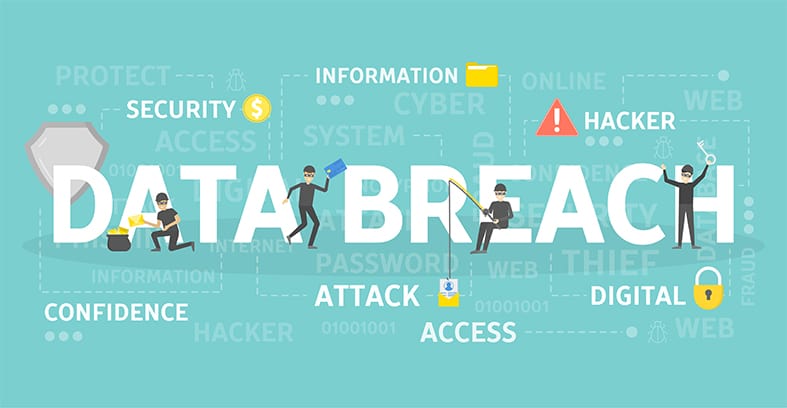Finally, any organization storing electronic records should ensure they have adequate security measures in place to protect against possible attacks. Companies need to consider implementing encryption techniques, regular system audits and employee training programs to help mitigate the risk of a successful cyber attack. To gain further insight into this issue, this article will explore the concept of ‘data breach’ in greater depth, focusing on associated threats and consequences.

Table of Contents
What Is A Data Breach?
A data breach occurs when unauthorized parties gain access to sensitive data. Data security is important for any organization, as a breach can lead to significant harm and disruption of operations. In the case of such an event, confidential information may be accessed or stolen by malicious actors. This could include financial details, personal records, business secrets and more. Such incidents have become increasingly common in recent years due to advances in technology that make it easier for attackers to penetrate systems quickly and without detection. The consequences of a data breach are severe; not only does it cost companies time and money to repair the damage done, but they also risk losing customer trust if their private information has been compromised. Additionally, fines from regulatory bodies may be imposed on organizations who fail to adequately protect their assets against breaches. It is clear then that maintaining strong data security measures is essential for all businesses today.
What Are The Types Of Data Breaches?
Data breaches can take many forms, each of which has a different risk to organizations and individuals. It is important for organizations to be aware of the types of threats they face in order to develop effective security measures. The following are some common data breach scenarios:
Data breaches have become increasingly common in the digital age, but what exactly is a data breach? Data breaches happen when sensitive or confidential information is accessed by an unauthorized third party. This can include credit card numbers, passwords and other personal details that are stored electronically. In many cases, these intrusions can cause serious harm to both businesses and individuals alike. As such, it’s important for everyone to understand not only what a data breach is, but also its potential threats and consequences.

Malware/Viruses: This type of attack occurs when malicious software infiltrates an organization’s system or network. Malware typically steals confidential information such as financial details and private records.
Identify Theft: Attackers use stolen identities to gain access to an individual or company’s accounts, credit cards, and other personal information. In some cases, attackers may also sell this data on the dark web.
Unauthorized Access: Hackers often exploit weak authentication systems or vulnerabilities in networks to gain unauthorized access to sensitive data. Once inside the system, hackers can steal valuable information such as financial documents and customer lists.
Phishing: Phishing is a type of social engineering attack that involves tricking people into revealing sensitive information. This can be done through fake emails, text messages, or websites that mimic legitimate ones.
Insider threats: Insider threats occur when someone within an organization accesses or shares sensitive information without authorization. This could be a disgruntled employee or a contractor who has access to sensitive data.
Physical theft or loss: Data breaches can also occur through physical theft or loss of devices that contain sensitive information. This can include laptops, smartphones, or USB drives.
Denial of Service (DoS) attacks: A DoS attack is designed to overwhelm a website or network with traffic, making it unavailable to legitimate users. This can prevent users from accessing or using the website, but it does not necessarily involve the theft of data.
SQL injection attacks: An SQL injection attack involves exploiting a vulnerability in a website or application that uses SQL (Structured Query Language) to access a database. This can allow an attacker to view, modify, or delete data in the database.
Ransomware attacks: Ransomware is a type of malware that encrypts a victim’s data and demands payment in exchange for the decryption key. This can prevent the victim from accessing their data until they pay the ransom.
Social engineering attacks: Social engineering attacks involve manipulating people into revealing sensitive information. This can be done through tactics such as pretexting (creating a fake scenario to trick someone into revealing information), baiting (offering something in exchange for information), or quid pro quo (offering something in exchange for information).
How Do Data Breaches Occur?
Data breaches occur when unauthorized access is gained to sensitive information. Data security breaches can be caused by human error, malicious attacks, or system failures and are usually the result of inadequate cyber-security protocols. It is important for organizations to have data forensics teams in place that can quickly identify any security breaches that may arise as a result of these threats.

The types of information exposed during a data breach depend on the type of breach that occurred. Commonly compromised data includes customer credit reports, social security numbers, bank account details, and other personally identifiable information (PII). In some cases, whole databases containing large amounts of personal information can be leaked or stolen due to vulnerabilities in an organization’s security systems. These leaks often have significant impacts on those affected since they could lead to identity theft or financial losses if their private information has been misused.
Note:
Organizations must take steps to ensure that their IT infrastructure is secure and up-to-date so as not to be vulnerable to data leaks. Companies should regularly review and update their policies related to data protection and cybersecurity measures in order to mitigate any potential risks posed by hackers or malicious actors attempting to unlawfully gain access to sensitive information.How To Identify A Breach
Identification of a breach is critical for any organization as it provides an opportunity to mitigate potential damages and losses that may be incurred from stolen credentials, credit monitoring and other related activities. Organizations must be aware of various techniques used by hackers in order to gain access to their system such as brute force attacks and they need to comply with legal requirements when detecting a data breach.
Organizations should have regular security audits performed on their systems so that any suspicious activity can be identified quickly. Additionally, organizations should keep track of user accounts and use encryption methods to secure passwords. Furthermore, it is important for organizations to monitor all incoming traffic into their networks regularly and maintain strict access control processes. Regularly reviewing logs will enable organizations to detect anomalies in usage patterns which could indicate malicious activity or attempts at gaining entry into restricted areas of the network.
It is essential for any organization to implement measures that help identify vulnerabilities within its IT infrastructure before any damage occurs due to a data breach. This includes monitoring users’ access rights, implementing strong authentication protocols and having robust intrusion detection strategies in place that are monitored continuously. By doing this, organizations not only protect their own interests but also those of their customers who rely on them for safe storage of personal information.
Implications Of A Breach. What Happens To Your Financial Information
When a massive data breach occurs, it can have serious implications for those affected. One of the most common threats associated with a data breach is identity theft. Since social security numbers and other personally identifiable information (PII) are often compromised during a breach, criminals may be able to use this information to open fraudulent accounts in your name or steal money from existing accounts. In addition to causing significant financial losses, victims of identity theft may also face long-term damage to their credit score and reputation.
To mitigate the risk posed by data breaches, organizations should take steps to prevent them whenever possible. These measures might include implementing strong password policies, monitoring user activities on systems containing sensitive data, encrypting all stored PII, and providing free credit monitoring services for impacted customers following a breach. By taking these proactive steps, companies can minimize the chances of becoming involved in a costly and damaging data breach incident.
Regulatory Requirements And Penalties
The implications of a data breach can be serious, leading to regulatory requirements and penalties for the organization responsible. After an incident is reported, organizations must comply with state laws regarding the notification of affected individuals. Depending on the type and size of the breach, this could involve sending out emails or physical mailings containing information about what happened and how victims may protect themselves going forward. Organizations may also have to provide free credit monitoring services for those who are affected by the breach. Additionally, companies may face legal fees associated with the investigation and other related costs such as providing customer support or public relations campaigns in response to the event.
Furthermore, businesses that experience a data breach must adhere to any applicable regulations set forth by relevant authorities like human services departments or financial institutions. This might mean strengthening existing systems to prevent future breaches or implementing new tools designed specifically for security purposes. Lastly, depending on the severity of the situation, perpetrators may face hefty fines, criminal charges, loss of their license and even jail time if found guilty. It is imperative that businesses take proactive steps towards preventing data breaches before they occur since ignoring these obligations could lead to significant consequences both legally and financially.
Cybersecurity Solutions
Data breaches are an increasing threat to individuals and organizations, posing consequences that range from financial losses to reputational damage. To mitigate the risks associated with data breaches, businesses should establish comprehensive security practices. This includes regularly updating software and systems, enforcing secure password policies, and educating employees on cyber threats such as phishing scams or fraudulent text messages. Additionally, companies should consider implementing two-factor authentication processes which require both a knowledge element (i.e., passwords) and possession element (i.e., driver’s license numbers, social security numbers).

Organizations can also take preventative measures by investing in technologies like firewalls and intrusion detection systems that monitor for suspicious activities within networks. Businesses must constantly evaluate their cybersecurity protocols to ensure all sensitive information is protected against potential attacks. Finally, it is essential for companies to remain compliant with applicable laws and regulations related to protecting customer data privacy. With these solutions in place, businesses can reduce the risk of suffering from a data breach while ensuring they remain in compliance with relevant laws and regulations.
The Cost Of A Data Breach
The consequences of a data breach can be severe, ranging from financial losses to reputational damage. Understanding the cost of a data breach is essential in order to reduce risk and limit damages.
To begin with, it is important for those affected by a data breach to take immediate steps to protect themselves.
This includes:
- Contacting one’s banks and credit bureaus
- Placing a fraud alert on their accounts
- Freezing their credit entirely
- Monitoring bank statements regularly for fraudulent activity.
Note:
Taking these measures ensures that any malicious activities stemming from the stolen account information will not go unnoticed and can be stopped quickly.Second, there may also be direct data breach costs associated with recovering such as legal fees, customer notification expenses and IT security audit services. According to IBM’s Cost of Data Breach Report 2020, the average total cost of a data breach in 2020 was $3.86 million USD worldwide across all industries. Companies can invest in cybersecurity solutions prior to experiencing a breach in order to drastically reduce this number. Finally, indirect costs must not be overlooked either; these include things like lost customer trust due to privacy concerns as well as diminished brand reputation, which could lead to revenue loss over time if not addressed properly.
In addition to financial losses, companies that fail to protect their customers’ sensitive data may face legal issues as well. Depending on the jurisdiction, there could be hefty fines for not properly safeguarding confidential information stored within an organization’s network infrastructure. Companies must adhere to industry regulations and standards when handling personal data if they want to avoid potential legal ramifications associated with a data breach.
Reputational Damage
A data breach is a security incident where confidential information, such as credit file or stolen data, is accessed by an unauthorized third party. Data breaches can occur through various attack vectors and have serious consequences for organizations and individuals alike. One of the most damaging effects of a data breach is reputational damage.
Organizations that suffer from a data breach may experience a decrease in consumer trust due to the mishandling of private information. Negative publicity stemming from the event can further reduce customer confidence, resulting in lost business opportunities and revenue losses. Reputation damage can take years to recover from, depending on how severe the breach was and how well it was addressed by management.
The best way to prevent reputational damage is through proactive measures such as employee training programs and proper system configurations which might help mitigate any potential threats before they become a reality.
Identity Theft And Fraud
Identity theft and fraud are two of the most common threats facing individuals in the wake of a data breach. In general, identity theft occurs when someone obtains personal information such as bank account numbers or credit card details for their financial gain. Fraudulent activities may include opening new accounts with stolen information, transferring funds from one account to another, accessing existing accounts without permission, or creating transactions that do not actually exist.

Victims of identity theft often experience long-term impacts including damaged credit reports and difficulty obtaining loans or other forms of financing. To help mitigate these risks, it is important to take proactive steps to protect your personal information following a data breach. Consumers should regularly monitor their bank statements and credit reports for suspicious activity, place a fraud alert on their credit report if needed, and be vigilant about protecting all passwords associated with online accounts containing sensitive information.
Despite best efforts to safeguard against potential repercussions after a data breach, some people may still fall victim to identity theft or fraud due to negligence or malicious intent on behalf of the attackers. Therefore it is essential for anyone who suspects they could have been impacted by an attack to seek immediate assistance from local law enforcement authorities and legal professionals in order to ensure their rights are protected during any subsequent investigations into the incident.
Legal Action Against Organizations
Organizations that suffer a data breach may face legal action as a result of the incident. A comprehensive monitoring system should be implemented to protect against unauthorized access and theft of data, which can lead to financial gain for malicious parties.
The consequences organizations face after suffering a breach are extensive:
- Civil litigation from customers whose personal or sensitive information was stolen;
- Criminal prosecution if any laws were broken in the process;
- Loss of reputation at the hands of public opinion;
- Regulatory fines and penalties imposed by governmental agencies.
This is important:
Unauthorized access to an organization’s confidential records is not only illegal but also unethical. Businesses must take steps to restrict access to critical systems, monitor closely for suspicious activity, and deploy security measures such as two-factor authentication and encryption technologies. Comprehensive monitoring is essential for early detection and response to potential threats, allowing companies to mitigate risks before they become more serious issues.Notifying Affected Individuals
In the event of a data breach, it is important to notify affected individuals in a timely manner. This allows them to take prompt action and mitigate potential threats. In order to effectively address security concerns, organizations must understand their system vulnerabilities and compromised credentials that were accessed during the breach. It is also essential for an organization to assess any military operations or other malicious activities that may have occurred on their systems as a result of the intrusion.
When notifying victims about information security breaches, small businesses should emphasize the importance of taking swift corrective measures and providing proper guidance for steps they need to take to protect themselves from further harm. By doing so, companies can minimize the risk of financial losses resulting from identity theft or fraudulent use of customer’s personal information. Furthermore, by proactively responding to data breaches, businesses can increase consumer trust and help ensure long-term success.
Organizations are ultimately responsible for protecting sensitive customer data and ensuring its safety through established protocols and preventive measures. Negligence in this area could expose customers to severe risks such as credit fraud, identity theft and privacy violations which could lead to costly reputational damage for the company involved. Therefore, it is critical for companies to remain vigilant when handling confidential information belonging to customers or employees alike
Publicizing The Breach
Publicizing a data breach is necessary to protect its victims. The public must be made aware of any incident that has compromised their personal information and the potential consequences associated with it. An IBM report indicates that cybercriminals often target the weakest link in an organization’s security infrastructure, which can jeopardize those who have been affected by the breach. Consequently, organizations must make sure that all relevant parties are informed about what transpired and take steps to safeguard them from further exploitation.
A crucial step is for organizations to provide notification services to inform customers or other stakeholders of a data breach so they can better understand the risks involved and take precautionary measures such as changing passwords or credit card numbers if need be. Additionally, companies should also consider offering access to identity protection services in order to help mitigate any damage done by the unauthorized disclosure of sensitive information. Furthermore, organizations should strive to create an environment where transparency and trust prevail between them and their consumers.
Developing A Response Plan
Organizations must be prepared with a response plan in order to mitigate the risk posed by these threats.
To effectively respond to a data breach, organizations should consider several steps:
- Identify affected systems: Mobile devices, other websites, and other servers may contain confidential information that could be compromised in a data breach. It is essential to identify which systems were impacted so appropriate measures can be taken to protect them from future attacks.
- Assess the extent of the breach: Once the affected systems have been identified, it is important to assess how much data has been exposed and determine if additional safeguards need to be implemented. By gathering this information quickly, organizations can minimize potential damage caused by the incident.
- Implement mitigation strategies: After determining the scope of the breach, it is necessary to develop and implement mitigation strategies designed to prevent similar incidents from occurring in the future. This may include implementing basic security patterns on systems containing sensitive information or beefing up access control policies across networks.
Prevention Strategies
It is extremely important to prevent data breaches, as the consequences can be severe. It is therefore essential that businesses of all sizes take measures to safeguard their data and customer information. Companies should start by ensuring they have a secure system in place with strong passwords, encryption technology, and other security features. They should also regularly review access privileges to ensure only those who need it have access to sensitive or confidential information. Organizations should also restrict physical access control to any computers where this type of data is stored, such as laptops or servers.
Furthermore, companies must practice caution when using search engines for business-related tasks; even if the intention is benign, hackers may still gain unauthorized access to company networks or systems through these searches. Moreover, organizations should refrain from storing financial information on computers or phone numbers online without proper protection. Such an approach can leave them vulnerable to malicious individuals using malware and phishing attacks.
While implementing additional security protocols can be time-consuming and costly for some businesses, it is a necessary step towards protecting against potential threats stemming from cyberattacks and data breaches. Taking steps now will help minimize future risk and keep both customers’ personal information safe as well as preserve the reputation of the organization itself.
It is essential for companies and individuals alike to stay vigilant about protecting their confidential information by understanding the different types of threats posed by data breaches and implementing effective countermeasures. Doing so can greatly reduce potential risks associated with cyberattacks and ensure that sensitive personal or corporate information remains secure.

